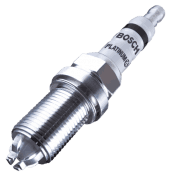 The spark plug is fitted to the engine cylinder head and positioned with its tip in the cylinder. There is one spark plug installed in each cylinder and its sole purpose is to ignite the compressed fuel and air mixture. This combustion is what creates the energy for the engine to rotate and output power. The spark plug is controlled via the engine ECU as it is crucial for the ignition to be timed to be in perfect sync with the engine rotation in order to maximise the output. Therefore, if lately, your engine has been misfiring or if your vehicle has been experiencing issues with acceleration, chances are your spark plug may have worn out or it may be faulty. Every engine cylinder contains its own spark plug and the number of plugs in a vehicle is dependent on the type of engine the car has. A V6 engine has six spark plugs, a V12 contains 12 and so on.
The spark plug is fitted to the engine cylinder head and positioned with its tip in the cylinder. There is one spark plug installed in each cylinder and its sole purpose is to ignite the compressed fuel and air mixture. This combustion is what creates the energy for the engine to rotate and output power. The spark plug is controlled via the engine ECU as it is crucial for the ignition to be timed to be in perfect sync with the engine rotation in order to maximise the output. Therefore, if lately, your engine has been misfiring or if your vehicle has been experiencing issues with acceleration, chances are your spark plug may have worn out or it may be faulty. Every engine cylinder contains its own spark plug and the number of plugs in a vehicle is dependent on the type of engine the car has. A V6 engine has six spark plugs, a V12 contains 12 and so on.
Spark plugs don’t wear out very quickly. Generally, they don’t have to be replaced until after 30,000-100,000 miles, however, this depends on the kind of car you drive and the kind of plugs in your vehicle. You may refer to your car manual if you’re unsure of the specific mileage for your car. Spark plugs worn with time can result in poor mileage, several problems in car performance and the possibility of your car not being able to start anymore. Hence, it is encouraged that you learn how to replace spark plugs on your own, once they reach the end of their life.
Required Tools:
- Spark Plug Socket
- Torque Wrench
- Feeler Gauge
- Ratchet Spanner
- Ratchet Spanner Extension
Depending on the vehicle, you may require additional tools to gain access to the plugs.
Step One: Locate your spark plugs.
Spark plugs are only fitted to petrol vehicles as they require a spark to ignite the air/fuel mixture. Diesel vehicles will use a glow plug, which glows at extremely hot temperatures to ignite highly compressed diesel/air mixture.
The spark plugs are located inside the cylinder head. On some vehicles, they will be dropped into the cylinder head from the top, whilst on others, they will have entry from the side at an angle. They are controlled through the Engine ECU using either a coil pack or HT Leads (High Tension Leads) also known as spark plug leads.
Step Two: Gaining Access To Your Spark Plugs.
Lift the bonnet and remove the engine cover. Locate the coil pack or HT leads and remove them. A coil pack may be bolted down to the cylinder head, which will need to be unbolted and then removed for the coil pack to lift up. HT Leads are not bolted down and can be pulled out. Carefully pull the plug wires up, you may need to use a bit of force as they often take a firm grip to the plugs.
Step Three: Detach your old plugs.
Using a clean rag, brush away any dust and debris you may find stuck around the spark plug. This guarantees that no debris will get stuck in your cylinders once your spark plug is out. Once it is clean, unfasten the plug by using the socket and after taking them out, check the ends of the spark plugs to look for any indication on the condition of your car. If the plug has a black liquid on the tip of it, this indicates that your car is running too rich on gasoline and air. On the other hand, white liquid shows a low gasoline-to-air ratio in your vehicle. It is recommended that you do this before throwing your old plugs into the garbage bin.
Step Four: Gap your plugs.
Using the feeler gauge, gap the new spark plugs you plan on installing. The gap required between the two electrodes is dependent on the type of car you own but normally it is between 0.02 to 0.06 inches. To find out the required gap for your car, refer to your vehicle’s manual.
Step Five: Install your new plugs.
Once you have set the correct gapping to the plug, simply reinstall them the same way they came out. Ensure they are tightened to the correct torque setting and then refit the coil/HT leads. Finally, you can shut your bonnet.
Your job is complete! If you think it may be too much hassle completing a spark plug replacement yourself or you simply don’t have the time (life is pretty busy nowadays), don’t worry, we at Sinspeed can do the job for you! Book your vehicle in at our automotive repair shop in Greenwich today!